- Updated independent Mineral Resource estimate, 964,000 tonnes @ 13.2% Zn and 3.5% Pb for 161,000 tonnes of contained metal in Indicated and Inferred categories.
- Total Level 7 Mining Area tonnage converted from Inferred to Indicated, 26,000t at 22.6% Zn, 12.8% Pb and 72.5g/t Ag, with an overall reduction in Indicated due to re-interpretation and mining.
- Re-interpretation of the geology for Plomosas has strengthened the understanding of the deposit, will assist in target generation to increase the resource and focus exploration work.
Consolidated Zinc Limited (ASX:CZL; “Consolidated Zinc” or “the company”) is pleased to announce its updated Mineral Resource estimate for its Plomosas zinc-lead-silver project in northern Mexico.
The resource estimate, independently completed by Ashmore Advisory Pty Ltd (“ASH”) in accordance with the JORC (2012) reporting guidelines, contains 964,000 tonnes @ 13.2% Zn and 3.5% Pb for 161,000 tonnes of contained metal in Indicated and Inferred categories.
This
is a decrease of 18% of resource tonnage and 14%
contained zinc metal over the previous resource
estimate announced to the ASX on 30 April 2018. The reduction in Mineral Resource
derives from the reinterpretation of the
geological models of Tres Amigos and Level 7 Semi-oxide (“SOX”) orezones.
Mineralised horizons of Tres Amigos are not as continuous as the 2018 model had
predicted and the Level 7 SOX orezone is cut by numerous post- mineralisation
faults that minimally displace the orebody down dip and along strike.
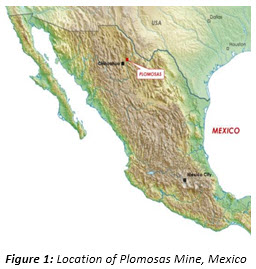
Mineral Resource classification was updated in Tres Amigos and Level 7 due to additional data and mining operations. At Level 7, channel sampling and diamond drilling allowed a larger geospatial extent to be classified as Indicated Mineral Resource however, due to changes in the geological interpretation, there was a reduction in total Indicated tonnage at Level 7. The additional mineralisation reported as Indicated that would otherwise be Inferred without the additional diamond drilling during 2020 at Level 7, amounts to 26,000t at 22.6% Zn, 12.8% Pb and 72.5g/t Ag. At Tres Amigos, the interpretation between the 2018 and 2020 estimates is quite different as a result of mining operations, which has resulted in a reduction in tonnage for the Indicated portion and global tonnage of the deposit.
Table 1 details the Mineral Resources by area and category whose locations are illustrated in Figure 2.
Mineral Resource Details and Parameters
Results of the independent Mineral Resource estimate by ASH for the Project are tabulated in the Statement of Mineral Resources in Table 1. The Statement of Mineral Resources is reported in accordance with the requirements of the 2012 JORC Code and is therefore suitable for public reporting.
The Mineral Resource is reported above a cut-off grade of 3% Zn which was based on the mining cut- off grade for the operation.
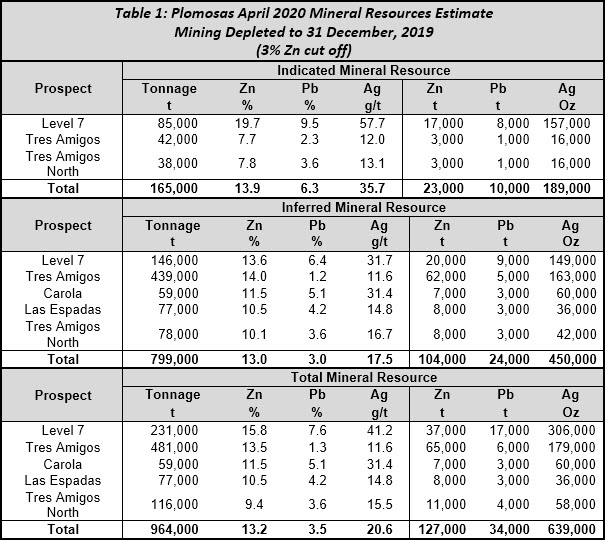
All Mineral Resources figures reported in the table above represent estimates at April 2020. Mineral Resource estimates are not precise calculations, being dependent on the interpretation of limited information on the location, shape and continuity of the occurrence and on the available sampling results. The totals contained in the above table have been rounded to reflect the relative uncertainty of the estimate. Rounding may cause some computational discrepancies.
The Mineral Resource has been estimated in accordance with the 2012 Edition of the ‘Australasian Code for Reporting of Exploration Results, Mineral Resources and Ore Reserves’ prepared by the Joint Ore Reserves Committee of The Australasian Institute of Mining and Metallurgy, Australian Geoscientists and Minerals Council of Australia (The JORC Code 2012).
A detailed discussion of the methodology and parameters used in estimating the Mineral Resources is provided in sections below along with an analysis of drilling, sampling and laboratory procedures and QA/QC protocols.
In summary:
- Ordinary Kriging (OK) was used to estimate average block grades using Surpac software and parameters derived from modelled variograms. Parent block sizes were 10m x 5m x 2.5m;
- Linear grade estimation was deemed suitable due to the geological control on mineralisation. Maximum extrapolation of wireframes from drilling was 20m along strike and 30m down-dip;
- The Mineral Resource estimate has been constrained by the wireframed mineralised envelope, is undiluted by external waste and reported above a Zn cut-off grade of 3%;
The Mineral Resource was classified as Indicated and Inferred Mineral Resource based on data quality, sample spacing, and lode continuity. The Indicated Mineral Resource was defined within areas of close spaced diamond drilling of less than 20m by 20m, and where the continuity and predictability of the mineralised units was assisted with development drives, along with mapping and channel sampling to assist with structural interpretation. The Inferred Mineral Resource was assigned to areas where drill hole spacing was greater than 20m by 20m and less than 40m by 40m; where small isolated pods of mineralisation occur outside the main mineralised zones, and to geologically complex zones.
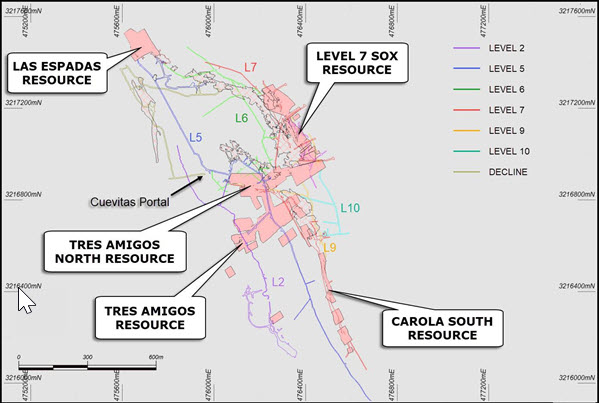
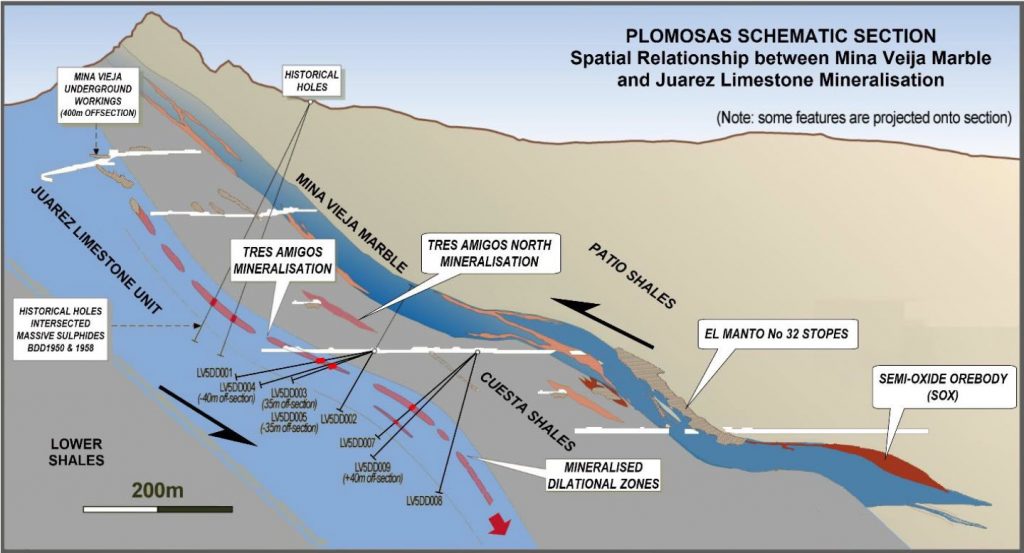
Geology and Geological Interpretation
Level 7
Mineralisation in the Level 7 SOX is structurally controlled with a plunge component of approximately 20o-30o to the southeast along a shallow dipping plane defined by the Mina Vieja Manto unit. Economic mineralisation in this system is coincident with flexures that host the thicker, high grade mineralisation. The structural setting of the Plomosas mineralisation also exhibits boudinaging that tends to create pinch-and-swell structures both down-dip (in the plunge-direction) and along strike.
The Level 7 Resource represents sulphide mineralisation that has been affected by late-stage oxidation by oxygenated water flowing through localised faulting. This manto-style sulphide mineralisation is present as ‘kernels’ within rinds of oxidised sulphides which can require a different metallurgical process to that of pure fresh sulphides as found in the Tres Amigos Resource.
Structural mapping at the Level 7 SOX has confirmed that these northeast faults have moved and jostled ore blocks up and down along the strike direction, making extraction of ore a challenging exercise. The movement of these blocks are no more than three to four metres in the vertical direction, as illustrated in Figure 4.
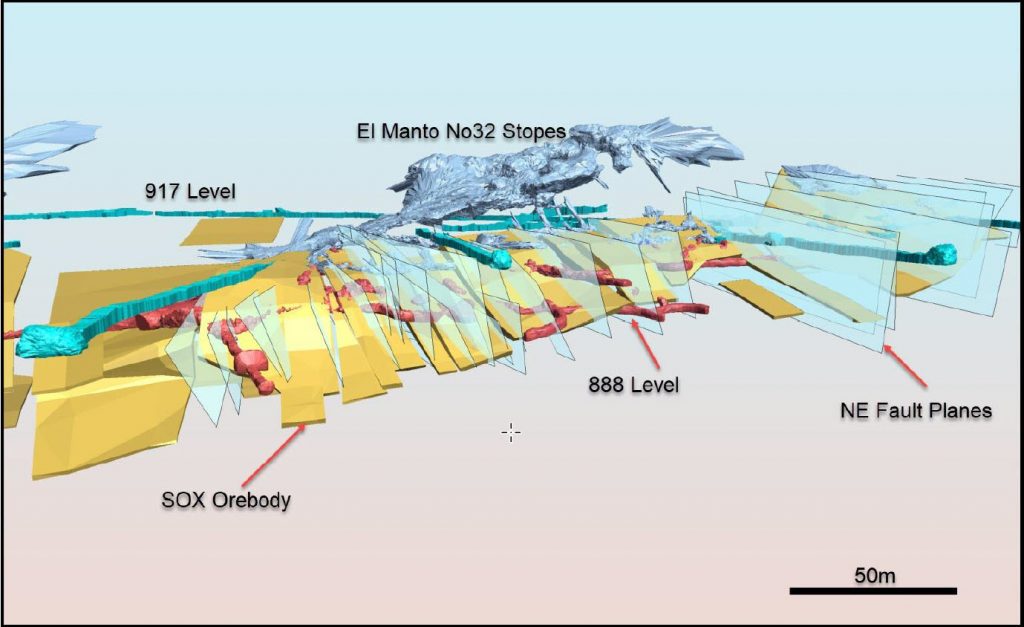
Tres Amigos
Additional mineralised structures have been previously defined in the underlying competent Juarez Limestone Unit (refer to Figure 3), occurring in the footwall to the Mina Vieja Marble. These are more discrete dilatant zones, commonly occurring as dilational sets or thin non-continuous units within the limestone.
The middle and lower zones are a product of a shear zone developed during the thrusting phase, with the shear recognisable as deformed limestone with quartz-sericite alteration. The shear can still be observed, without mineralisation being present.
The shear zone is a host to these ‘string-of-pearls’ pods of ore, which tend to orientate themselves to the southeast at around 130 – 140° along an open fold plane, which is defined by the surface contact of the Juarez Limestone . The geometry of the mineralised dilatants zones are such that the long-axis of the dilatants pitch and plunge 130 – 140° to 20° along a 055° dipping plane. These repeat in an en-echelon array, migrating southeast along the plane as shown in Figure 15.
For this reason, the Tres Amigos ore zones are discontinuous and poddy along the main hosting structural shear.
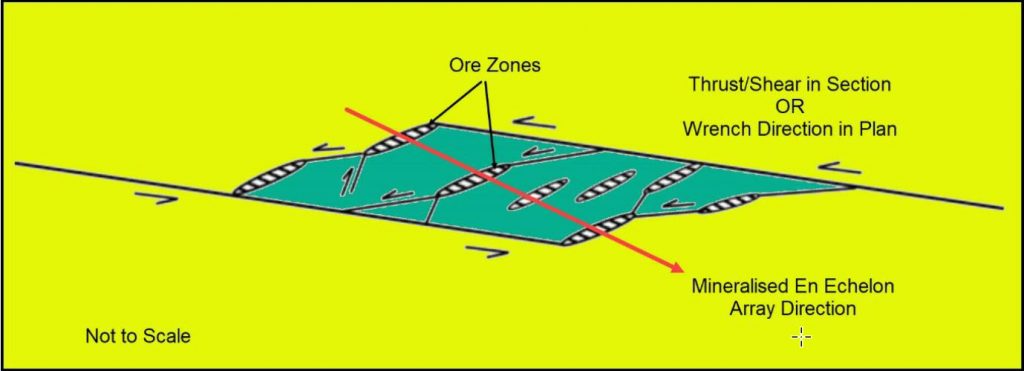
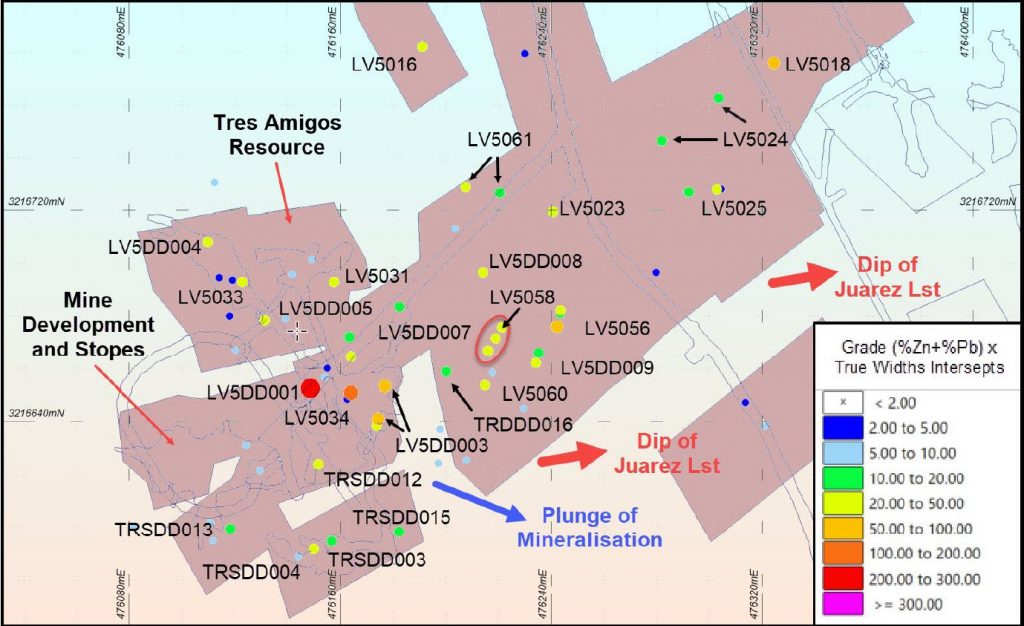
The geological setting and mineralisation styles in Plomosas is continually being defined as drilling and additional data is collected and the geological model is updated. As evidenced at Las Espadas and Carola South this information will determine the future exploration procedures and techniques required to develop targets that will result in additional tonnes and grade for future mill plant feed.

Additional Work Program
Any future drilling will focus on converting additional resources from Inferred to Indicated and infill drilling at the Tres Amigos Resource along with the southern offset portion of Level 7 as drill positions become available. The re-interpretation of the geology for Plomosas has strengthened the understanding of the deposit, will assist in target generation to increase the resource and focus exploration work.
Detailed Discussion of Resource Estimation Methodology and Parameters
Sampling and Sub-Sampling Techniques
Sampling of cut channels was conducted by locating a one metre sampling line, using spray paint across mineralisation and ensuring that the line began in hanging wall host, spanned mineralisation and terminated in footwall host. Where mineralisation was thicker than one metre, the line was adjusted accordingly. This was done to minimise the bias of the sample value. Channel sampling was then completed, using the line as a guide, without sampling the line itself. As much representative sample was taken from the length of the line to produce a two to four-kilogram sample. For this level of exploration, the sample size and method of sampling was deemed adequate to represent in-situ material.
Sampling techniques employed at the Plomosas underground drilling program include saw cut NQ drill core samples. Diamond NQ3 core was sampled on geological intervals/contacts, with the minimum sample size of 0.5m and max 1.2m. Core was cut in half, with one half to be sent for analysis at an accredited laboratory, while the remaining half was stored in appropriately marked core boxes and stowed in a secure core shed. Duplicates were quarter core, sampled from the half sent for analysis.
Drilling Techniques
NQ triple tube core (NQ3) is currently being used to drill out the geological sequences and identify zones of mineralisation that may or may not be used in any Mineral Resource estimations, mining studies or metallurgical testwork.
Sample Analysis Method
All drill samples were submitted to ALS Laboratories in Chihuahua City for sample preparation with sample pulps sent to ALS in Toronto, Canada for multi-element analysis using a 30g charge with a multi-acid digest and ICP-MS or AAS finish (ME-ICP61). Over the limit results were routinely re- assayed by ore grade analysis OG62. Over the limit results for the ore grade were re-assayed by titration methods Cu-VOL61, Pb-VOL50 or Zn-VOL50.
Analyses include 51 elements and include Ag, Au, Cu, Pb, Zn as the main elements of economic interest. The methods and procedures are appropriate for the type of mineralisation and the techniques are considered to be total.
Estimation Parameters
Using parameters derived from modelled variograms, Ordinary Kriging (OK) was used to estimate average block grades in three passes using Surpac software. Linear grade estimation was deemed suitable for the Plomosas Mineral Resource due to the geological control on mineralisation. Maximum extrapolation of wireframes from drilling was 20m along strike and 30m down-dip. This was equal to the drill hole spacing in these regions of the Project. Maximum extrapolation was generally half drill hole spacing.
The parent block dimensions used were 10m NS by 5m EW by 2.5m vertical with sub-cells of 0.625m by 0.625m by 0.625m. The model was rotated to align with the strike of the mineralisation on a bearing of 330°. The parent block size dimension was selected on the results obtained from Kriging Neighbourhood Analysis that suggested this was the optimal block size for the dataset.
The deposit mineralisation was constrained by wireframe solids constructed using a nominal 2% combined Zn and Pb cut-off grade with a minimum down-hole length of 1m. The wireframes were applied as hard boundaries in the estimate.
Statistical analysis was carried out on data from 53 domains. After review of the project statistics, it was determined that high grade cuts for Ag within two domains were necessary. The cut applied was 300g/t Ag resulted in two composites being cut.
An orientated ‘ellipsoid’ search was used to select data and adjusted to account for the variations in lode orientations, however all other parameters were taken from the variography derived from Domain 1. Up to three passes were used for each domain. The first pass had a range of 30m, with a minimum of 6 samples. For the second pass, the range was extended to 50m, with a minimum of 4 samples. For the final pass, the range was extended to 100m, with a minimum of 2 samples. A maximum of 16 samples was used for all three passes.
It is assumed that the bulk density will have some variation within the mineralised material types due to the host rock lithology and sulphide minerals present. Therefore, a regression equation for Zn and density was used to calculate density in the block model.
Validation of the model included detailed comparison of composite grades and block grades by strike panel and elevation. Validation plots showed good correlation between the composite grades and the block model grades.
Mineral Resource Classification Criteria
The Mineral Resource estimate is reported here in compliance with the 2012 Edition of the ‘Australasian Code for Reporting of Exploration Results, Mineral Resources and Ore Reserves’ by the Joint Ore Reserves Committee (JORC). The Mineral Resource was classified as Indicated and Inferred Mineral Resource based on data quality, sample spacing, and lode continuity. The Indicated Mineral Resource was defined within areas of close spaced diamond drilling of less than 20m by 20m, and where the continuity and predictability of the mineralised units was assisted with development drives, along with mapping and channel sampling to assist with structural interpretation. The Inferred Mineral Resource was assigned to areas where drill hole spacing was greater than 20m by 20m and less than 40m by 40m; where small isolated pods of mineralisation occur outside the main mineralised zones, and to geologically complex zones
Cut-off Grade, Mining and Metallurgy Methods and Parameters Considered to Date
The Statement of Mineral Resources has been constrained by the mineralisation solids and reported above a Zn cut-off grade of 3%. The cut-off grade was estimated based on current mining cut-off grades for the operation.
ASH considers the Mineral Resource demonstrates reasonable prospects for eventual economic extraction however, highlights that additional studies and drilling are required to confirm economic viability.
This announcement was authorised for issue to the ASX by the Directors of the Company. For further information please contact:
Brad Marwood
Managing Director
08 9322 3406
ABOUT CONSOLIDATED ZINC
Consolidated Zinc Limited (ASX: CZL) owns 100% of the historic Plomosas Mine, located 120km from Chihuahua City, Chihuahua State, Mexico. Chihuahua State has a strong mining sector with other large base and precious metal projects in operation within the state. Historical mining at Plomosas between 1945 and 1974 extracted over 2 million tonnes of ore grading 22% Zn+Pb and over 80g/t Ag. Only small-scale mining continued to the present day and the mineralised zones remain open at depth and along strike.
The company has commenced mining at Plomosas and is committed to exploit the potential of the high-grade Zinc, Lead and Silver Mineral Resource through the identification, exploration and exploitation of new zones of mineralisation within and adjacent to the known mineralisation with a view to identify new mineral resources that are exploitable.
Competent Persons’ Statement
The information in this report that relates to exploration results, data collection and geological interpretation is based on information compiled by Steve Boda BSc (Hons), MAIG, MGSA, MSEG. Mr Boda is a Member of the Australian Institute of Geoscientists (AIG). Mr. Boda has sufficient experience that is relevant to the style of mineralisation and type of deposit under consideration and to the activity that is being undertaken to qualify as Competent Person as defined in the 2012 edition of the ‘Australasian Code for Reporting of Exploration Results, Minerals Resources and Ore Reserves’ (JORC Code). Mr. Boda consents to the inclusion in the report of the matters based on his information in the form and context in which it appears.
The information in this report that relates to Mineral Resources is based on information compiled by Mr Shaun Searle who is a Member of the Australasian Institute of. Mr Searle is a full time employee of Ashmore Advisory Pty Ltd. Mr Searle has sufficient experience which is relevant to the style of mineralisation and type of deposit under consideration and to the activity which he has undertaken to qualify as a Competent Person as defined in the 2012 Edition of the ‘Australasian Code for the Reporting of Exploration Results, Mineral Resources and Ore Reserves’. Mr Searle consents to the inclusion in this report of the matters based on his information in the form and context in which it appears.
Original Article: https://www.consolidatedzinc.com.au/wp-content/uploads/2020/04/20200429-Updated-Mineral-Resource-ASX-LODGEMENT-FINAL.pdf

















